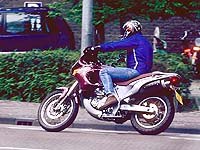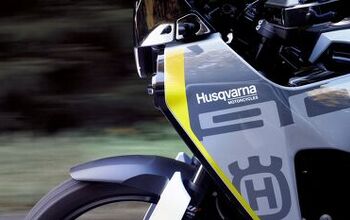Church of MO: 1997 Aprilia Pegaso 650
When Aprilia, with her showers sweet the drought of March hath pierced to the root, and when Jesus rolls into Cinco de Mayo to make glorious spring out of our winter’s discontent, and to party, he doesn’t always show up on an interesting thumper, but 22 years ago he did. And so it is written, and so sprouted another ADV seedling.
————————————————————————————
First Impression: Aprilia Pegaso 650
La Nuova Frontiera
Aprilia has been selling large-capacity dual purpose machines for more than 10 years. First came the ETX600 and later the Tuareg, both bikes using the same 2-valve engine supplied by Austria’s Rotax company. In 1993, the first Pegaso was introduced, with cosmetics that took it sharply out of the dirt and into the city. It also saw a change of engine to the 5-valve water-cooled Rotax engine that is still present on this latest version. Brembo disc brakes appeared on the second version of the Pegaso in 1995, along with a quieter exhaust to meet EEC regulations and updated graphics. Beyond the cosmetics that have once again been updated for 1997, biggest changes for the “-3” variant are its new frame with 1.5 cm longer wheelbase, increased rake and trail and a revised airbox.
Just as its predecessors, this bike is a lot of fun to ride. Nail the throttle and its Rotax engine pulls very cleanly, spinning through to the 7500 rpm redline more quickly than you’d expect from a large capacity single. Aggressive use of the clutch will lift the front wheel, but you have to consciously flog the engine to make this happen. Claimed power output is 49 bhp at the crankshaft, and the engine feels strong, so we were surprised when a run on a Dynojet dynamometer showed just 40 bhp. Our machine probably feels stronger due to its fat spread of torque from 3500 to 6000 rpm. It is also versatile enough for riders too lazy for frequent gear changes. Let the revs drop down under 3000 rpm, snap the throttle open and the Pegaso will shudder through 3000 rpm and pull normally up through its powerband, that starts at 4500 rpm.
A balancer-shaft is intended to damp out vibrations, but it is only partially effective. Footrests start to tingle at 4000 rpm, and quite sharp vibrations are felt at the bars and seat from 6000 rpm. The only other minor criticism of the otherwise excellent engine is a slight surge when riding under 4000 rpm. It doesn’t actually stumble, but feels like it might. Only five speeds are offered from the gearbox, although a sixth gear would allow higher-speed cruising under the band of engine vibration. The Pegaso’s clutch is very light and the gear changes slick, its only glitch being a false neutral between third and second when downshifting with the bike stationary.Changes to the Aprilia’s chassis have resulted in a slightly slower-steering bike. It is still very nimble through traffic, and although requiring a little more work, cuts through corners with excellent stability. The Michelin TX66 tires fitted to our test machine have a very light off-road pattern and worked exceptionally well on tarmac, allowing you to crank the Pegaso over to sport bike angles without a hint of traction loss. With its high footrests and no center stand, ground clearance is endless. You’d have to be very close to running off the edge of the tires before anything touched down.
Taking a gentle detour through the woods along a hardened fire-road has the Pegaso coping reasonably well. Unfortunately, the inverted Marzocchi forks are quite soft and cannot be adjusted, while the Boge rear shock has a virtually inaccessible rebound damping adjuster. Quicken the pace, or move into rougher terrain and the suspension is quickly overwhelmed. Avoid heavy sand at all costs. The Michelins can’t cut through it and the bike digs itself in. Suddenly its 352-pound weight feels more like 600 pounds and you’re trying to heave a full-dress ‘Wing out of kitty litter.
With a fuel tank that hold 22 liters of unleaded and an engine that gulps at a miserly 16 to 20 Km per liter (39 to 50 mpg), you can expect a range of about 400 Km (250 miles). Owners will be praying it were shorter, as one thing Aprilia has not got right is the Pegaso’s seat. It feels luxuriously soft as you first ease yourself into the saddle, but after an hour you begin to feel like you’re sitting on the upper frame tubes. Spend a day in the saddle of the Pegaso and you’ll need a week to recover. Strange really, as Aprilia clearly had some light touring in mind, as witnessed by the optional set of hard-shell cases that clip straight on to its standard rack. A handy centerstand is also offered as an accessory. The really dedicated owner can also splash out for an optional fully adjustable rear shock, with remote reservoir for dialing compression and rebound damping.
Overall the Pegaso is a pretty decent motorcycle, but who exactly buys them? Aprilia’s new Pegaso is selling very well, but the customer is difficult to characterize. They are not generally first-time buyers. It would make an excellent commuter vehicle, except it also sells well in Northern Europe where it always seems to rain during morning rush hour, discouraging two-wheelers. The seat is a little tall, making it less attractive to women, although like BMW’s F650, a kit is available to lower the seat even further. There is too little left of the dirtbike heritage to attract the Dominator/XT/DR/KL rider. It doesn’t have the pace of a sportbike, or the comfort and smoothness of a tourer.Perhaps, we might just be witnessing the birth of a new type of market segment — the Urban All-rounder — visually impressive and flexible enough to be used for many different roles. BMW’s F650, following the same concept and built by Aprilia using the 4-valve Rotax engine, has been a great success – but most likely as a result of its tank badge. The fact that Suzuki has introduced a very similar bike called the Freewind this year suggests that they too believe a new segment is emerging. It can be said Aprilia was in there at the start, and have given the rest of the world a tough act to follow with their Pegaso 650.
Specifications:Horsepower and Torque Charts
Manufacturer: Aprilia/Rotax
Model: 1997 Pegaso 650-3
Dutch Price: Fl. 14,490 ($7,600)
Engine: Liquid-cooled, 4-stroke DOHC, 5-valve single-cylinder
Bore x stroke: 100 x 83 mm
Displacement: 652cc
Compression Ratio : 9.0:1
Carburation: Mikuni BST33
Transmission: 5-speed
Wheelbase: 1480 mm
Seat Height: 840 mm
Fuel Capacity: 22 L
Claimed Dry Weight: 161 Kg (352 lbs)
Price Comparison:
(Holland)
BMW F650 – Fl. 14,950 ($7,870)
Suzuki Freewind – Fl. 13,499 ($7,100)
Honda NX650 Dominator – Fl. 14,950 ($7,870)
Thanks to Bruggeman Motoren, Nieuw Vennep, Holland for the use of their Dynojet dyno.
More by John Burns





































Comments
Join the conversation